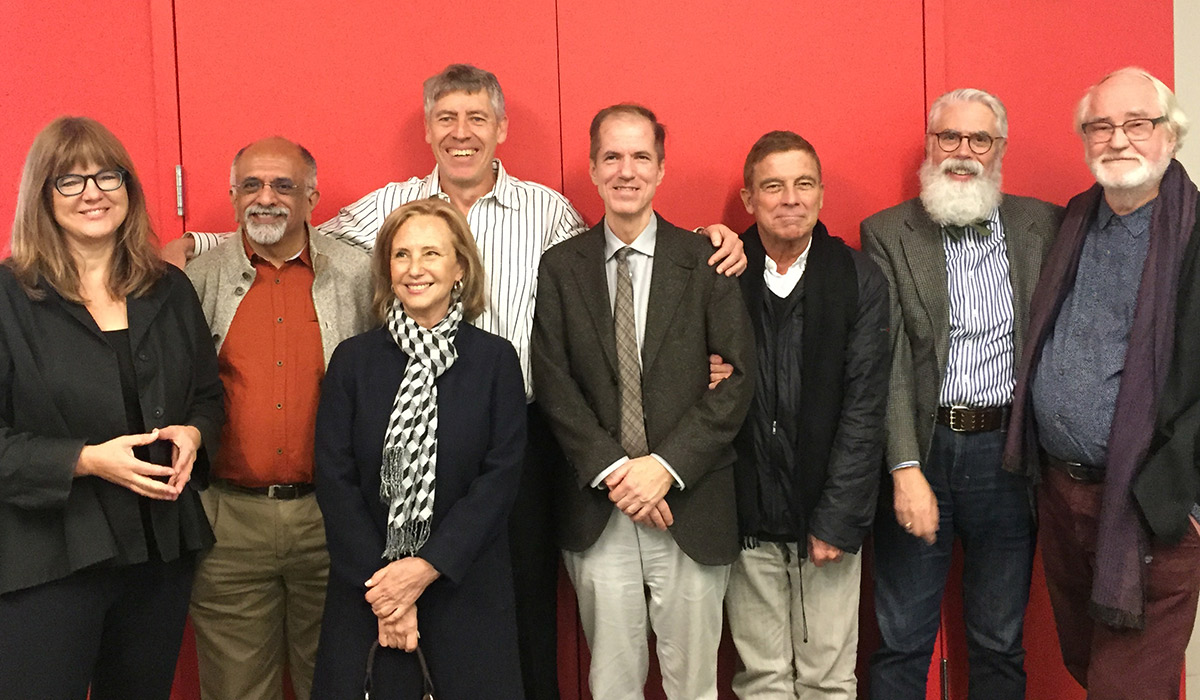

What are the intersections between architecture and spirituality? And how can architects create spaces that inspire transcendence? Those were the questions at the heart of a recent discussion panel hosted by The Catholic University of America’s School of Architecture and Planning.
The discussion, entitled “Journey to the Forbidden Zone: Spirituality and Culture in Architectural Education,” was the kick-off event for a four-day lecture series marking the 10th anniversary of the school’s Walton Critics program, a program which brings accomplished architects from around the world to campus for a year of lectures, design studios, and face-to-face interactions with students.
As part of the series, six of the 10 past and present Walton Critics returned to campus to share what they experienced through the program. The opening night panel discussion, held on Oct. 24 in the Crough Center’s Koubek Auditorium, was moderated by 2015 Walton Critic Michael Crosbie, editor-in-chief of Faith and Form.
“At many schools of architecture, discussions of the spiritual and the sacred simply don’t exist. They’re relegated to the forbidden zone,” said Crosbie. “The questions opened to consideration here can be challenging and some might say difficult. But immersing yourself in difficult questions pushes you out of your comfort zone.”
Additional panelists included past critics Prem Chandavarkar of Bangalore, India; Alberto Campo Baeza of Madrid, Spain; Eliana Bormida of Mendoza, Argentina; Juhani Pallasmaa of Helsinki; and Susan Jones of Seattle.
“I don’t think we’ve ever had this kind of architectural firepower in this building at one moment before,” said Architecture Dean Randall Ott, during his introductory remarks for the event. “It’s amazing the roof is still on.”
The series was planned by professor Julio Bermudez, director of the Cultural Studies and Sacred Space program who oversees the Walton Critic program. During his introductory remarks, he thanked the critics for their commitment to the program and for “inspiring work in architecture for so many years and so many to come.”
“This series reiterates the high quality architectural education that the Walton program enables our school to offer,” Bermudez said. “An education that puts focus on spirituality and faith vis-à-vis the big questions of our lives through the design of both sacred and secular buildings is hard to find elsewhere.”
Reflecting on his own time as a critic, Crosbie said Catholic University’s architecture school is one of the only institutions where students are invited to consider the role of spirituality in design. After sharing a few student testimonials about the Walton Critic program, Crosbie said that architecture can be about more than just good design. Rather, he said, it can be about “creating places that give people a momentary pause, a place to pray, transform, and transcend.”
As the discussion began, each critic was asked to explain how they have found spiritual fulfillment through their work. Jones, the 2018 critic, said she finds inspiration through spending time in nature and through teaching, which she calls “one of the most giving and empathetic moments of my life.”
“Teaching became a pathway for me and it’s always a great moment listening to students try to express their ideas and investigate what they have to say,” she said. “It’s a transcendent moment where you’re listening and invited into someone else’s world.”
Pallasmaa, who was the 2011 Walton Critic, said he has always thought of architecture as “a privilege in that it offers an extraordinary position to view human nature and life, and a responsibility in terms of bringing existential meaning to the human condition.”
Together with faith and science, architecture and other forms of art can allow people to understand the world in a new way, Pallasmaa said. It can also shine a light, or “glorify,” the values of a society, whatever those may be.
2014 Walton Critic Bormida said she advises students of architecture to embrace the spiritual aspects of their education in order to become more complete designers. In order to have an impact, she said, architects need to learn to listen to their own voices and follow their unique instincts with their work.
“We should be conscious that we are always following a parallel process of education,” she said. “On one hand, you are following a formal education coming from the university which is trying to give you the tools to design … but you are also responsible to mature in the other dimension of your existence, which is spirituality and culture. This comes from your childhood, what you read, what you talk about, and what you listen to from your parents. That continues all your life.”
Similarly, Chandavarkar, the 2016 Walton Critic, said architects need to think about what their designs can say through them, rather than what they can say about their designs.
“A fault in our education is that we’re always standing next to our work talking about it,” he said. “Schools have us believe that it is our intention as architects that gives meaning to the work. What you have to do is empower the building to speak for itself.”
Campo Baeza spoke about the importance of designing structures that focus on more than just aesthetics and instead use beauty to point to the divine.
“Our buildings must accomplish function and construction, but they must also accomplish emotion and must transmit beauty,” said Campo Baeza.